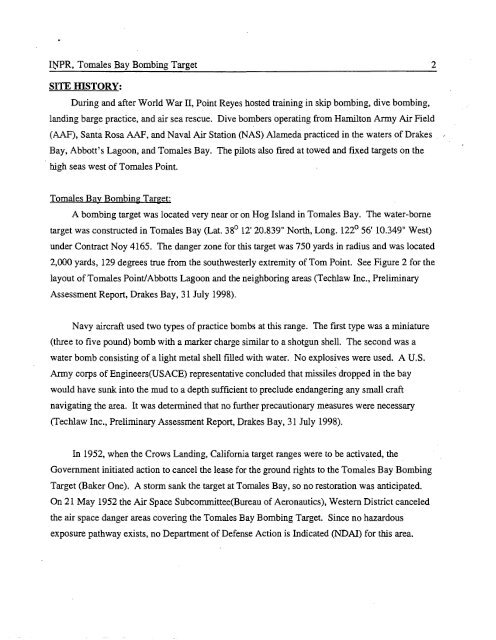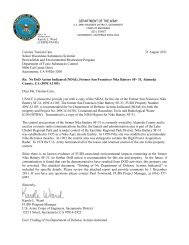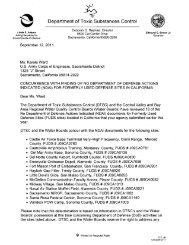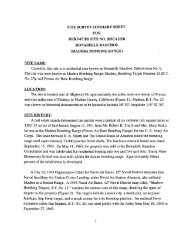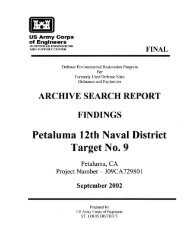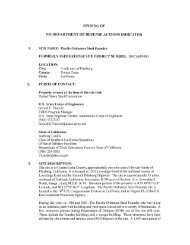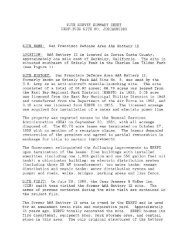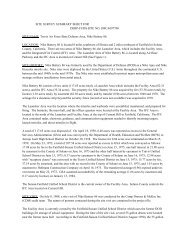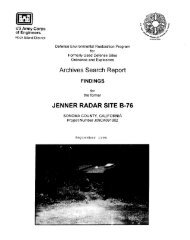Tomales Bay Abbotts Lagoon Bombing Range ... - Corpsfuds.org
Tomales Bay Abbotts Lagoon Bombing Range ... - Corpsfuds.org
Tomales Bay Abbotts Lagoon Bombing Range ... - Corpsfuds.org
You also want an ePaper? Increase the reach of your titles
YUMPU automatically turns print PDFs into web optimized ePapers that Google loves.
IYPR, <strong>Tomales</strong> <strong>Bay</strong> <strong>Bombing</strong> Target<br />
SITE HISTORY:<br />
During and after World War 11,Point Reyes hosted training in skip bombing, dive bombing,<br />
landing barge practice, and air sea rescue. Dive bombers operating from Hamilton Army Air Field<br />
(AAF), Santa Rosa AAF, and Naval Air Station (NAS) Alameda practiced in the waters of Drakes<br />
<strong>Bay</strong>, Abbott's <strong>Lagoon</strong>, and <strong>Tomales</strong> <strong>Bay</strong>. The pilots also frred at towed and fixed targets on the<br />
high seas west of <strong>Tomales</strong> Point.<br />
<strong>Tomales</strong> <strong>Bay</strong> <strong>Bombing</strong>; Tarpet:<br />
A bombing target was located very near or on Hog Island in <strong>Tomales</strong> <strong>Bay</strong>. The water-borne<br />
target was constructed in <strong>Tomales</strong> <strong>Bay</strong> (Lat. 38' 12' 20.839" North, Long. 122' 56' 10.349" West)<br />
under Contract Noy 4165. The danger zone for this target was 750 yards in radius and was located<br />
2,000 yards, 129 degrees true from the southwesterly extremity of Tom Point. See Figure 2 for the<br />
layout of <strong>Tomales</strong> Point/<strong>Abbotts</strong> <strong>Lagoon</strong> and the neighboring areas (Techlaw Inc., Preliminary<br />
Assessment Report, Drakes <strong>Bay</strong>, 31 July 1998).<br />
Navy aircraft used two types of practice bombs at this range. The first type was a miniature<br />
(three to five pound) bomb with a marker charge similar to a shotgun shell. The second was a<br />
water bomb consisting of a light metal shell filled with water. No explosives were used. A U.S.<br />
Army corps of Engineers(USACE) representative concluded that missiles' dropped in the bay<br />
would have sunk into the mud to a depth sufficient to preclude endangering any small craft<br />
navigating the area. It was determined that no further precautionary measures were necessary<br />
(Techlaw Inc., Preliminary Assessment Report, Drakes <strong>Bay</strong>, 31 July 1998).<br />
In 1952, when the Crows Landing, California target ranges were to be activated, the<br />
Government initiated action to cancel the lease for the ground rights to the <strong>Tomales</strong> <strong>Bay</strong> <strong>Bombing</strong><br />
Target (Baker One). A storm sank the target at <strong>Tomales</strong> <strong>Bay</strong>, so no restoration was anticipated.<br />
On 21 May 1952 the Air Space Subcornmittee(Bureau of Aeronautics), Western District canceled<br />
the air space danger areas covering the <strong>Tomales</strong> <strong>Bay</strong> <strong>Bombing</strong> Target. Since no hazardous<br />
exposure pathway exists, no Department of Defense Action is Indicated (NDAI) for this area.<br />
2


